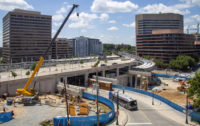An extension of the Southwest Light Rail Transit (Southwest LRT) in Minnesota is nine years behind schedule and $1.5 billion over budget, according to a recently released report from the state legislature’s Office of Legislative Auditor, a nonpartisan auditing service.
The Southwest Light Rail green line extension was designed to connect downtown Minneapolis with suburban communities of Eden Prairie, Hopkins, Minnetonka and St. Louis Park. The project began in 2011 with an expected completion date in 2018. Lunda/C.S. McCrossan was awarded the civil construction contract for a low bid of $799.5 million for what will be the state’s largest infrastructure project to date. The project includes construction of 16 new transit stations, two light rail tunnels and a 14.5-mile track. It is currently not expected to be completed until 2027. As of August, about 60% of the line had been built, mostly west of the city. But only 40% of a wall and tunnel through the city center, including stabilization of the foundations of nearby buildings, is finished.
The audit found three main factors driving the project’s cost overruns and delays:
- Disagreement over the route and its proximity to the existing freight line
- Construction of a complex and controversial tunnel in Minneapolis’ environmentally sensitive Kenilworth corridor
- The need for a concrete barrier wall between freight rail and light rail traffic
The fight over these issues among the Metropolitan Council—which is overseeing design, engineering, construction and future operations of the light rail line—and the environmentalists and local residents is only one source of the delay. As of April 29, the council had approved 622 change orders, with a net cost of $225 million, according to the audit report. About 73% of the change orders pertained to the civil construction contract, 20% to modifications of the operations and maintenance facility, and 6% to the systems contract.
The design and engineering contractor for the project, AECOM Technical Services, first complained about the change orders and quality of construction back in 2019, according to an auditor’s letter. “There has been a prolonged and significant difference of opinion between representatives of the Metropolitan Council and AECOM regarding the preparation of independent cost estimates on the Southwest LRT project, as well as other project issues,” the auditor’s letter reads. “We have not examined the validity of AECOM’s allegations or the council’s responses.”
Not all contractors involved are as critical of the project’s progress. “In our opinion, the Metropolitan Council and Lunda C.S. McCrossan joint venture are really working together efficiently, but this is a very complex project,” says Dennis Behnke, president and CEO of Lunda Construction. “The civil portion of the Southwest Light Rail Project has been impacted by over 1,000 owner-requested and third-party plan changes.”
The most expensive and project-slowing plan changes have included “adding a crash wall between an existing freight rail and light rail, changes and delays to the Kenilworth tunnel, a complex cut-and-cover tunnel shoehorned between a condominium complex and an active freight rail, and adding a station,” Behnke adds.
He says that his companies and the council have been working “cooperatively to deliver the project at the least cost while mitigating schedule delays.”
Jointly agreed-on changes, Behnke said, include:
- Rebaselining the project schedule
- Resequencing the 16 project segment completion dates to turn over completed portions of the project as soon as possible
- Adding interim milestones in an effort to reduce delay and increase efficiency
- Agreeing to an alternative dispute resolution process to cooperatively resolve open project issues and disputes
Minnesota State Rep. Frank Hornstein, who initiated the audit and who is chair of the House Transportation Finance and Policy committee, blames most of the delays and overruns on siting the light rail line alongside the freight line.
“There was a viable option to route the freight line where it was originally 20 years ago," he says. "Instead, they co-located it with light rail, which required building a tunnel in a very narrow corridor in a very sensitive soil area between two lakes. What the report found – what many of us knew already – was that this decision to build this tunnel and locate it where it is was a political decision. It wasn't based on technical analysis because all the technical reports up until 2012 said that doesn't make sense to do this. But then there were objections from the suburbs where the freight rail was going to go, so they flipped.”
When the project was announced in 2011, the council estimated a cost of $1.25 billion. As of the time of the audit report, the budget had more than doubled to $2.74 billion. The council hasn’t publicly identified a source for a more than $500 million shortfall — more than 20% of the current budget.
Bonnie Kollodge, a spokesperson for the council, says the council is working toward coming up with a funding solution to cover the shortfall by the end of the year.
Whether it was possible to avoid building the tunnel, Kollodge says: "The tunnel construction is underway and ongoing after years of planning and design. Any construction shutdown, permanent or otherwise, would only cause costs to increase and result in additional disruption to surrounding areas."
She says the council follows guidelines laid out by the state for the bidding process and any changes to the process would have to be made by the state legislature.
After approving the legislative audit of the project, Scott Newman, chairman of the Senate Transportation Committee Chairman said on the floor of the Senate: “They’ve gone too far to stop, and it’s too expensive to go ahead. What are they going to do? Keep wasting taxpayer money.”



Post a comment to this article
Report Abusive Comment